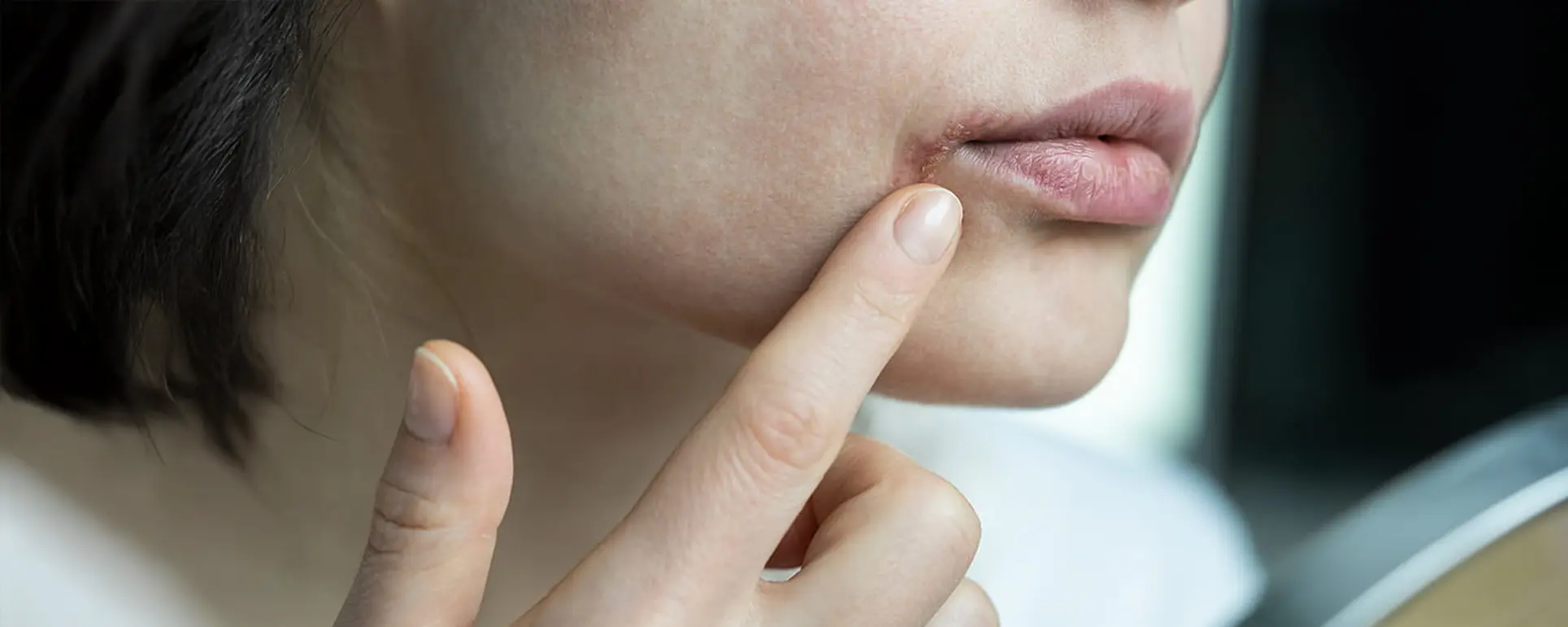Cracks, redness, or painful sores at the corners of the mouth are a surprisingly common issue that many people experience at some point in their lives. While these fissures may appear minor initially, they can quickly become uncomfortable, making everyday activities like eating, drinking, speaking, or smiling not only inconvenient but sometimes quite painful. Some people may also notice additional symptoms such as itching, burning, or a raw, irritated feeling around the affected areas, which can affect confidence and make social interactions uncomfortable.
This condition is medically referred to as angular cheilitis, a form of inflammation that specifically affects the corners of the mouth. Although it is generally not considered dangerous, angular cheilitis can become persistent or recurrent if its underlying causes are not properly addressed. Chronic cases may interfere with daily life, making it essential to understand what triggers the condition and how it can be effectively treated.
Angular cheilitis can arise from a wide range of factors. Nutritional deficiencies particularly a lack of iron, folate, or B vitamins are common contributors. Infections caused by bacteria or fungi can also play a significant role, especially in individuals with weakened immune systems or those prone to frequent moisture around the mouth. Certain lifestyle factors, such as habitual lip licking, nail-biting, or using ill-fitting dentures, can worsen the condition by creating a moist environment that encourages irritation and infection. Additionally, underlying medical conditions like diabetes, immune system disorders, or skin conditions may make some people more susceptible to developing angular cheilitis. Even environmental factors, including cold weather, wind, or excessive drooling during sleep, can trigger or exacerbate the problem.
Because the condition can stem from multiple causes, effective treatment often requires a combination of approaches, including addressing nutritional deficiencies, treating infections, and making simple lifestyle adjustments. Understanding these causes is crucial not only to relieve immediate discomfort but also to prevent the condition from returning. With proper care and timely intervention, most people can achieve full healing, restore comfort to the corners of their mouth, and reduce the risk of recurrence.
Recognising angular cheilitis early and taking steps to manage it can make a significant difference in daily life. By identifying triggers and adopting preventive strategies, you can protect the delicate skin at your mouth’s corners, minimise irritation, and ensure that simple actions like eating, talking, and smiling remain pain-free.
What Is Angular Cheilitis?

Angular cheilitis is a medical condition characterised by inflammation of the skin at the corners of the mouth. This inflammation can manifest in several ways, often causing discomfort and irritation that can interfere with everyday activities. Some common signs and symptoms include:
- Redness and irritation: The affected skin often appears red and swollen, which can be the first noticeable sign of the condition.
- Painful cracks or fissures: Small splits or cracks may form at the corners of the mouth, sometimes making it uncomfortable to eat, talk, or smile.
- Dryness or flaking skin: The skin in the area may become dry, rough, or flaky, which can worsen the discomfort.
- Occasional bleeding: In more severe cases, the cracks may bleed slightly, especially if the skin is stretched or irritated further.
While angular cheilitis can affect people of all ages, it tends to be more common in certain groups. Older adults are at higher risk, particularly if they wear dentures or have dental issues that create folds at the mouth corners. People with nutritional deficiencies such as low levels of iron, folate, or B vitamins may also be more prone to developing this condition, as these nutrients play an essential role in maintaining healthy skin.
Additionally, habits like frequent lip licking, thumb sucking, or biting the lips can contribute to excess moisture or friction at the corners of the mouth, increasing the likelihood of developing angular cheilitis. In some cases, the condition may also be associated with underlying health issues such as diabetes or a weakened immune system, which can make it harder for the skin to heal.
Recognising the early signs of angular cheilitis and understanding who is most at risk is important for timely intervention. By addressing the underlying causes and taking preventive steps, most cases can be treated effectively, reducing discomfort and lowering the chances of recurrence.
Common Causes of Painful Cracks
Angular cheilitis is a condition characterised by painful cracks and inflammation at the corners of the mouth. While it may seem minor, it can cause significant discomfort, making everyday activities such as eating, speaking, or even smiling uncomfortable. The causes of this condition are often multifactorial, meaning that several contributing factors can interact to trigger or worsen the problem. By understanding these causes in detail, you can take steps to prevent recurrence, manage symptoms effectively, and support faster healing.
Fungal or Bacterial Infections
One of the most common contributors to angular cheilitis is infection. The corners of the mouth naturally collect moisture from saliva, creating a warm and damp environment where microorganisms can thrive. Candida yeast, a type of fungus, is frequently responsible for infections in this area. When overgrown, it can lead to redness, swelling, and painful cracking. Bacterial infections, particularly from Staphylococcus species, can also develop, especially when the skin is already irritated or broken.
Certain habits increase the risk of infection. For example, habitual lip licking, drooling during sleep, or using poorly fitted dentures can allow saliva to pool in the mouth corners, further promoting microbial growth. Recurrent infections can lead to chronic inflammation, deeper fissures, and even secondary infections that may require topical or oral medication. Maintaining good oral hygiene and keeping the area dry are essential steps to reduce the risk of infection-related angular cheilitis.
Dry Skin and Environmental Factors
Environmental conditions and daily habits play a crucial role in the development of angular cheilitis. Cold weather, low humidity, strong winds, and indoor heating can strip the skin of its natural moisture. This dryness reduces the skin’s elasticity and resilience, making it more prone to cracking and inflammation.
Additionally, personal habits such as lip licking, biting the corners of the mouth, or picking at peeling skin can worsen the condition. Even minor irritation from these behaviours can break down the skin barrier, allowing bacteria or fungi to penetrate and cause infection. Protective measures are essential to prevent these cracks from forming. Using moisturising lip balms, applying barrier ointments, staying well-hydrated, and avoiding repetitive irritation are all effective strategies to maintain healthy skin around the mouth.
Nutritional Deficiencies
Diet and nutrition have a significant impact on skin health and the body’s ability to repair itself. Certain nutrient deficiencies are directly linked to angular cheilitis, including iron, vitamin B2 (riboflavin), and vitamin B12.
Iron deficiency can reduce the body’s capacity to produce healthy red blood cells, which are vital for oxygenating tissues and supporting skin repair. Riboflavin deficiency may cause inflammation and cracking at the corners of the mouth, while a lack of vitamin B12 can impair the nervous system and compromise skin integrity.
Ensuring a well-balanced diet that includes leafy greens, lean meats, eggs, dairy products, and fortified foods is key to preventing nutrient-related angular cheilitis. In cases where dietary intake is insufficient, supplements prescribed by a healthcare professional can help correct deficiencies and reduce the risk of recurring symptoms.
Underlying Medical Conditions
Certain medical conditions can make individuals more susceptible to angular cheilitis. People with diabetes are particularly prone because high blood sugar levels can promote the growth of fungi and bacteria. Immune system disorders, which weaken the body’s ability to fight infections, can also increase vulnerability to this condition.
Dental issues, such as poorly fitting dentures, braces, or other orthodontic devices, can trap moisture in the corners of the mouth, creating an environment conducive to cracking and infection. Additionally, gastrointestinal conditions that interfere with nutrient absorption like celiac disease or inflammatory bowel disease can contribute to deficiencies that trigger angular cheilitis. Proper management of these underlying conditions, along with maintaining good oral hygiene, is essential in preventing recurrent outbreaks.
Lifestyle Habits and Other Contributing Factors
Beyond infections, dryness, deficiencies, and medical conditions, certain lifestyle habits and external factors can further contribute to angular cheilitis. Smoking, for instance, can impair skin healing and reduce blood flow to the lips, delaying recovery. Excessive sun exposure may dry out the lips and surrounding skin, making them more prone to cracks.
Other irritants, such as harsh toothpaste, mouthwashes containing alcohol, or spicy and acidic foods, can exacerbate inflammation and prolong healing. In some cases, stress and hormonal fluctuations can also affect skin health, increasing susceptibility to irritation.
Adopting preventive habits is key to reducing both the severity and frequency of angular cheilitis. This includes:
- Applying protective ointments or moisturisers before exposure to harsh weather.
- Avoiding repetitive lip-licking or picking at the skin.
- Maintaining a balanced diet rich in essential vitamins and minerals.
- Practising proper oral hygiene and ensuring dental appliances fit correctly.
By addressing both internal and external factors, it is possible to minimise discomfort and support the skin’s natural healing process, reducing the likelihood of recurring painful cracks.
How Dermatologists Diagnose and Treat Angular Cheilitis

Angular cheilitis is a condition that, while often considered minor, can cause considerable discomfort due to painful cracks, redness, and inflammation at the corners of the mouth. Because several different factors ranging from infections to nutritional deficiencies can contribute to its development, it is important to seek professional guidance. A dermatologist is trained to accurately diagnose angular cheilitis, distinguish it from other conditions with similar symptoms, and recommend the most effective treatment plan tailored to the individual.
Diagnosis: Identifying the Root Cause
Dermatologists start by carefully examining the affected area. The appearance of redness, swelling, fissures, and any signs of infection can provide important clues. In some cases, additional tests may be conducted, such as:
- Swab tests: To detect the presence of Candida yeast or bacterial infection.
- Blood tests: To check for underlying nutritional deficiencies, such as low iron or vitamin B12 levels.
- Medical history review: To identify conditions like diabetes, immune disorders, or denture use that may predispose someone to angular cheilitis.
Accurate diagnosis is key because it ensures that treatment targets the underlying cause rather than just addressing the symptoms. Misdiagnosis can prolong discomfort and increase the risk of recurrence.
Topical Antifungals and Antibiotics
If the dermatologist determines that a fungal infection, such as Candida, is present, topical antifungal creams or ointments are commonly prescribed. These medications help eliminate the fungal overgrowth while reducing inflammation and discomfort.
In cases where a bacterial infection is contributing to the condition, topical antibiotics may be recommended, and in more severe or persistent cases, oral antibiotics may be necessary. Using the correct antimicrobial treatment is crucial for controlling the infection and preventing it from spreading or recurring.
Moisturising Balms and Barrier Creams
Angular cheilitis is often worsened by dryness and constant exposure to saliva, which can irritate the delicate skin at the mouth corners. Dermatologists frequently advise using moisturising balms or protective barrier creams to maintain hydration, protect the skin from further irritation, and promote natural healing.
These products work by creating a physical barrier over the affected area, reducing friction, locking in moisture, and allowing the skin to repair itself more efficiently. Consistent application, especially in harsh weather conditions or during activities that may expose the skin to saliva, is important for preventing flare-ups.
Nutritional Support
Nutritional deficiencies can play a significant role in the development and persistence of angular cheilitis. Iron, vitamin B2 (riboflavin), and vitamin B12 deficiencies are particularly common contributors. A dermatologist may recommend dietary adjustments or supplements if deficiencies are detected.
A nutrient-rich diet that includes leafy greens, lean meats, eggs, dairy products, whole grains, and fortified foods can help improve skin health and accelerate healing. In cases where supplementation is required, dermatologists typically provide guidance on appropriate dosage and duration, ensuring the deficiencies are corrected safely and effectively.
Lifestyle Advice and Preventive Measures
Dermatologists often provide guidance on lifestyle changes that can help prevent angular cheilitis from recurring. These may include:
- Avoiding habitual lip licking or biting, which can further irritate the skin.
- Practising good oral hygiene to reduce bacterial buildup.
- Using protective lip balms in cold, dry, or windy conditions.
- Ensuring dental appliances, such as dentures or braces, fit properly to minimise saliva pooling.
By addressing these behavioural and environmental factors, patients can create conditions that allow the skin to heal fully and reduce the risk of repeated flare-ups.
The Importance of Early Intervention
Seeking dermatological care as soon as symptoms appear can make a significant difference in both the duration and severity of angular cheilitis. Early intervention helps to:
- Minimise pain and discomfort.
- Promote faster healing of cracks and inflammation.
- Reduce the likelihood of recurrent episodes.
- Prevent secondary infections that may arise from untreated cracks.
Through a combination of accurate diagnosis, targeted medical treatment, nutritional support, and practical lifestyle advice, dermatologists can manage angular cheilitis effectively. Most cases respond well to this comprehensive approach, allowing the corners of the mouth to heal completely and remain healthy over time.
Additional Tips for Ongoing Care
Even after the condition has healed, maintaining preventive care is essential. This includes continuing the use of moisturising balms, monitoring diet for essential nutrients, and maintaining proper oral hygiene. Regular check-ins with a dermatologist may also be recommended for individuals who experience recurrent angular cheilitis, ensuring that any underlying causes are addressed promptly.
When to Seek Professional Help
While mild cases of angular cheilitis may sometimes improve with over-the-counter remedies or simple home care, it is important to know when professional intervention is necessary. Consulting a dermatologist ensures accurate diagnosis, appropriate treatment, and prevents complications that could prolong discomfort.
You should consider seeking professional help if any of the following occur:
- Cracks persist for more than a week
Healthy skin usually begins to heal within a few days. If the cracks at the corners of your mouth do not show signs of improvement within a week, this may indicate an underlying infection, nutritional deficiency, or another condition that requires medical attention. - Pain is severe or worsening
Mild discomfort is common with angular cheilitis, but sharp or increasing pain, especially when eating, speaking, or smiling, is a sign that the condition may need stronger treatment than simple moisturisers or home remedies can provide. - Signs of infection appear
Red flags include pus or discharge, increased swelling, warmth around the affected area, or even systemic symptoms such as fever. These signs indicate that bacteria or fungi may have taken hold, and prompt medical care is essential to prevent the infection from worsening or spreading.
Seeking professional care also helps identify any underlying factors contributing to angular cheilitis, such as vitamin deficiencies, diabetes, immune system disorders, or dental issues. A dermatologist in London can perform a thorough examination, recommend appropriate topical or oral treatments, advise on lifestyle adjustments, and provide guidance on nutritional support. This tailored approach not only resolves current symptoms but also helps prevent future flare-ups, ensuring lasting relief and healthier skin at the corners of your mouth.
Final Thought: Effective Care for Healthy, Pain-Free Corners of the Mouth
Angular cheilitis may seem minor, but repeated or severe cracks can impact daily life and comfort. With the right care, including topical treatments, nutritional support, and lifestyle adjustments, most cases heal quickly. You can get in touch with a Dermatologist in London to assess your condition and receive expert treatment for angular cheilitis, ensuring the corners of your mouth stay healthy and pain-free.
References:
- Federico, J.R. (2023). Angular Cheilitis. StatPearls Publishing. Available at: https://www.ncbi.nlm.nih.gov/books/NBK536929/
- Cabras, M., Gambino, M., & Mazzoni, A. (2020). Treatment of angular cheilitis: A narrative review and meta-analysis. Oral Diseases, 26(6), pp. 1317–1326. Available at: https://onlinelibrary.wiley.com/doi/abs/10.1111/odi.13183
- Blagec, T., et al. (2023). Cheilitis: A cross-sectional study multiple factors involved. Oral Diseases. Available at: https://pubmed.ncbi.nlm.nih.gov/36001068/
- Park, K.K. (2011). Angular Cheilitis, Part 1: Local Etiologies. MDedge. Available at: https://cdn-uat.mdedge.com/files/s3fs-public/Document/September-2017/087060289.pdf
- Rose, J.A. (1971). Folic-acid deficiency as a cause of angular cheilitis. The Lancet, 297(7691), p. 1262. Available at: https://www.sciencedirect.com/science/article/abs/pii/S0140673671926262
